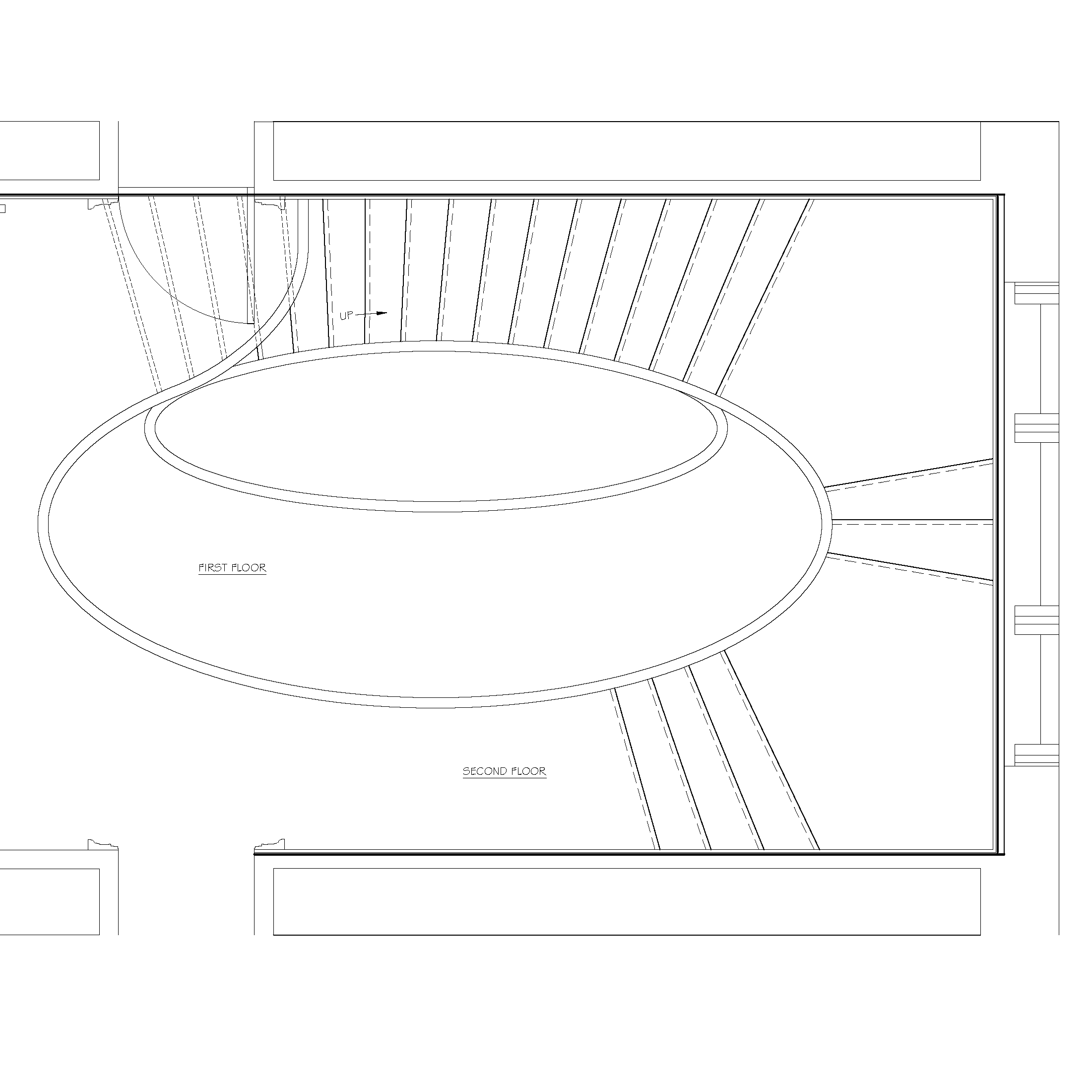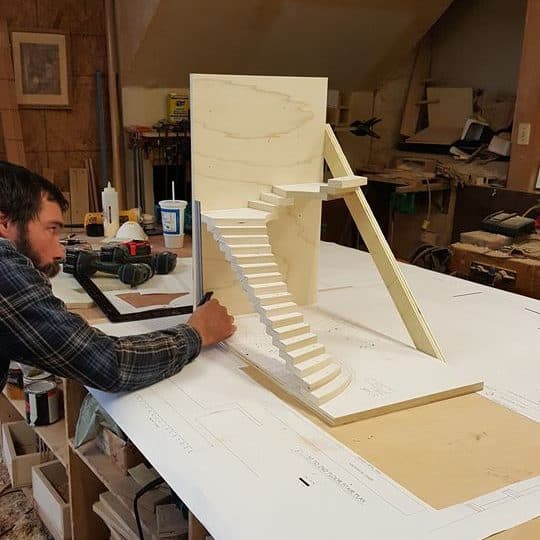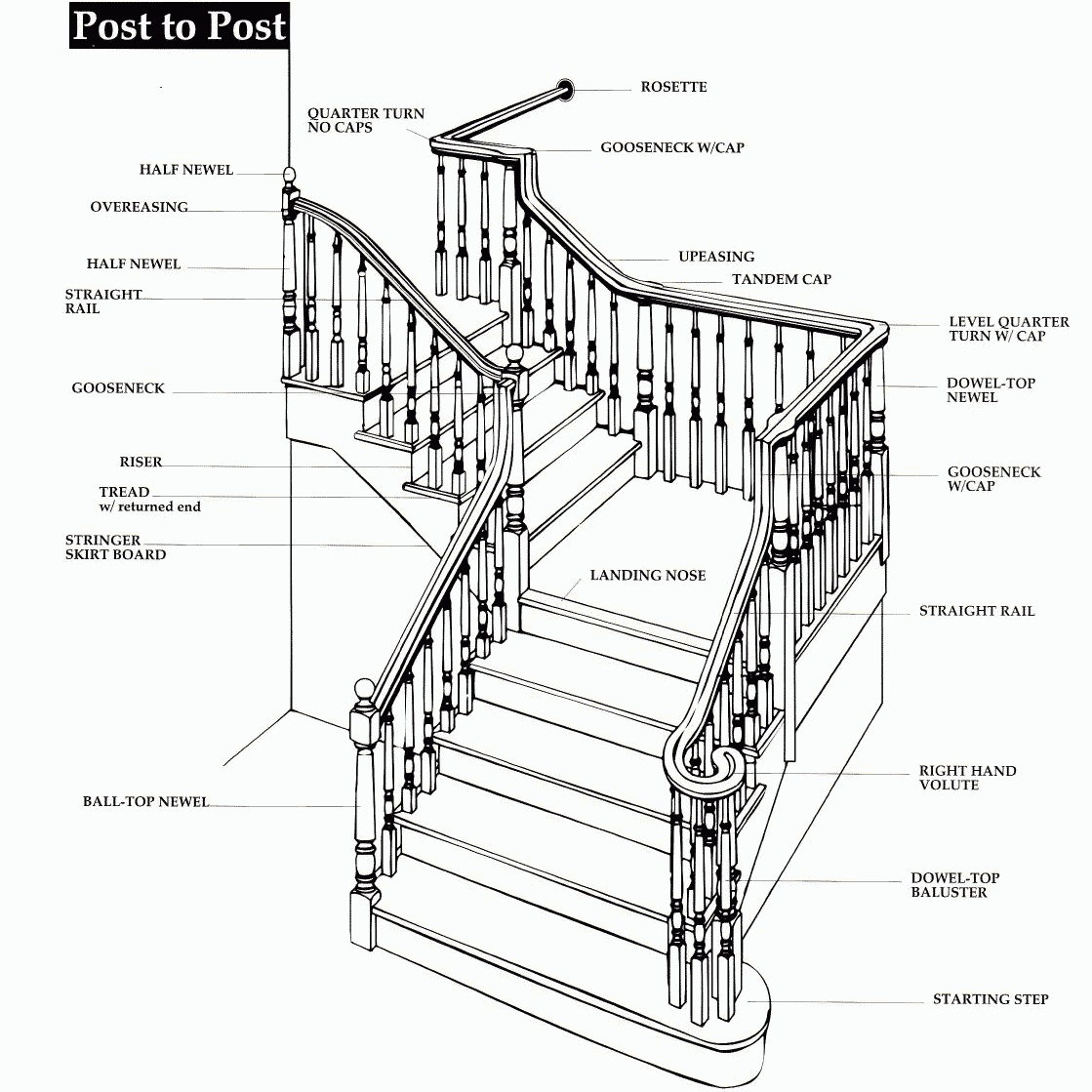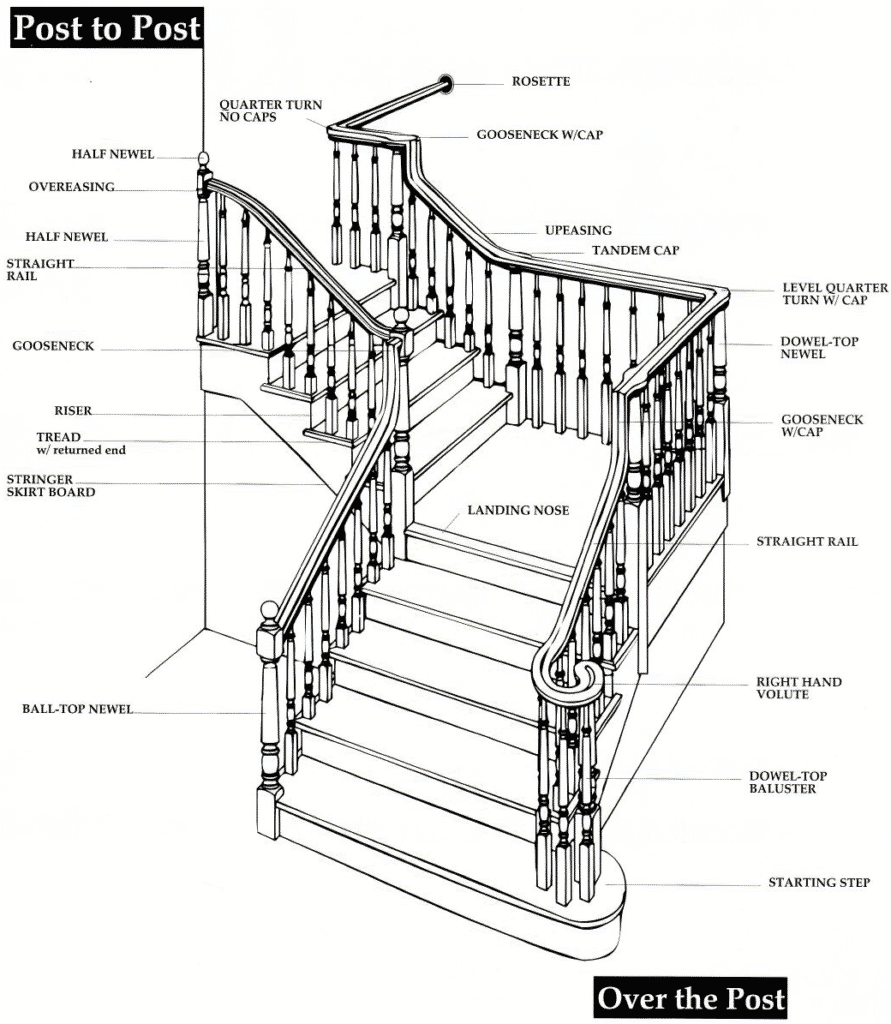Glossary
This Glossary is intended to provide a helpful tool for parts and terms sometimes used when determining the requirements and choices in your staircase design.
BALUSTERS A vertical stair part turned, carved or otherwise vertical section placed between the handrail and the stair tread or stair
BALUSTRADE A rail system including the framework of rail, newels and balusters.
BRACKETS Ornamental pieces used on the skirt boards and stair stringers. Several different variations exist from carved to scroll. Typically they are 3/16″ thick and made from the same wood species as the rest of the stair system.
BOX Straight stairs with closed stringers.
BULL NOSE A rounded front to a board.
CARRIAGES The angled pieces used to support the stair system and for the treads to rest upon.
COVE MOULD Molding placed under the treads and landing treads, typically 3/4″ x 5/8″.
CLOSED STRINGERS A staircase in which the ends of the treads are not visible to the outside. Used in box stairs.
CODE The rules adopted by a state and/or local authorities that govern how a stairway must be put together for safety reasons.
CURVED STAIR Stairs that curve as they ascend.
EASING The curved junctions placed in a handrail to bring the parts at different levels into one flowing curve. A fitting that curves in a vertical plane, used to change the angle of the handrail.
EPOXY A two-part adhesive used to bond various materials including wood, composites, and metals. Epoxies are especially useful in bonding metal to wood in stair applications. Epoxies vary in strength, setting time and elasticity once cured.
FILLET A thin strip that fills the plowed (grooved) rail space between balusters in a hand rail or shoe rail.
FINIAL The ornamental top of a newel post. Usually turned, sometimes carved. Box newels often receive an optional finial.
FITTINGS Pieces of wood that are shaped with the same profile as handrail to form changes of direction for the handrail. Used in “over-the post” installations. Examples of fittings are volutes, turn outs, tandem caps, easing, and goosenecks.
FLIGHT An uninterrupted series of steps and stringers reaching from one landing to the next. A flight may be straight or curved.
FLUTES Flutes are decorative vertical grooves placed in a wood surface such as a baluster or newels.
GRADIENT OF A STAIR The ratio between run of the stair and the rise of the stair; the angle of inclination.
GUARDRAIL A protective railing designed to prevent people or objects from falling into open well, stairwell or other open spaces.
GOOSENECK A combination of an easing and a fitting in a rail system which allows the handrail to change heights from an incline back to the level. Placed at landings or at the top of a stair. Allows the use of the same top block on newel at each transition.
HANDING The direction a stair part is designed to be used. Handing is right or left. The orientation of the handing is always determined by standing at the bottom of the staircase and looking up.
HANDRAIL A molded rail following the pitch or rake of the staircase, and forming the top or connecting piece of the balustrade.
HEADROOM The vertical distance from the lowest point of the ceiling or soffit directly above the stair to the point of rake. Most codes require 6’8″ (80 in).
JATOBA The technical name for Brazilian Cherry
LANDING A resting place at the middle or top of a flight of stairs. Landings are often used to change the direction of a stair.
NEWELS OR NEWEL POST A solid square, or turned section of vertical post at the center and at regular turns and transitions of a rail system. The newels provide the main support for the rail system. There is a starting newel at the base of the stairs and a landing newel at the turns or top of the stair.
NOSING The front edge of the tread which projects beyond the face of the riser. It is usually rounded.
OPEN FLIGHT a stair that is open or without a wall on one or both sides.
OPEN STRINGER A stringer or skirt board that is cut out for the treads and risers. Typically the tread will have a return that hangs over the skirt board to finish the look.
OPENING CAP A fitting or portion of the rail system which begins with a round cap and is connected to the handrail.
OPEN WELL STAIR a stair with two or more flights around an open space.
PIN TOP BALUSTER A baluster having dowel type top rather than a square. This type of baluster is attached to the handrail by drilling a hole into the handrail and inserting the top of the baluster into the handrail.
PITCH The angle of the staircase. Determined by the rise and run. 460
PLOWED RAIL A handrail which has had the bottom grooved or plowed to accommodate a square top baluster. Fillet is used to fill the space between balusters.
POSTS see newels.
QUARTER TURN FITTING A machined block of wood that matches the handrail and allows a 90 degree change of direction. The fitting may have a round cap to accommodate the newel or it may be the same width as the handrail and make the turn without the elongation need to accommodate a newel.
RAIL SYSTEM The balustrade. Used to describe a complete rail system consisting of the handrail, newels, fittings and balusters.
RAKE The stair “rake” is the slope or angle of the staircase.
RISE The vertical distance between the upper surfaces of two consecutive treads.
RISERS The vertical face of a step.
RUN The horizontal dimension between the face of two consecutive risers.
SHOE RAIL A plowed base rail that is used to accept the bottom end of square balusters. The shoe rail often sits on a short wall or it may float above the treads.
SOFFIT The visible sloping under-surface between the stair stringers.
SPINDLES The balusters or turned, carved or otherwise, vertical sections placed between the handrail and the stair tread or stair stringer.
SPIRAL STAIRS Stairs, which rise regularly around a cylinder or elongated cylinder either real or imaginary. Sometimes called helical stairs.
STAIR Series of steps
STEP One unit of a stair, consisting of a riser and a tread.
SQUARE TOP BALUSTER Balusters with square tops rather than the more commonly used pin tops. Square top balusters require plowed rail and fillets.
STAIR TREAD The horizontal surface of a step.
STARTING TREAD OR STEP The first tread and riser at the bottom of the stair. Starting steps are usually rounded on the ends to accept volutes or turn outs.
STAIRWELL The framed opening in the floor that incorporates the stairs.
STRINGER The inclined boards or laminations in which the treads and risers are attached. Stringers provide the support for the stairs.
TANDEM CAP A fitting that matches the handrail profile with a round enlarged portion in the middle designed to accommodate a newel.
TURN OUT A fitting used to start a rail system. The turn out flares left or right slightly to give the appearance that the stairway is enlarged and inviting.
VENEER A thin sliced wood used to cover wood. Veneer is often used in tread ends and stair stringers.
VOLUTE A decorative way to start a stairway. The volute is round with a newel in the center surrounded by balusters and ascending to the rake of the handrail.
WALL RAIL Used where a stair runs alongside a wall and is attached to the wall with rail brackets.
WINDER Tread that is narrower at one end than the other. Used to turn corners or go around curves.
WREATHED HANDRAIL A handrail which has a very complex rail profile that has to follow a curve and rise of the staircase all while keeping the profile of the handrail level.




